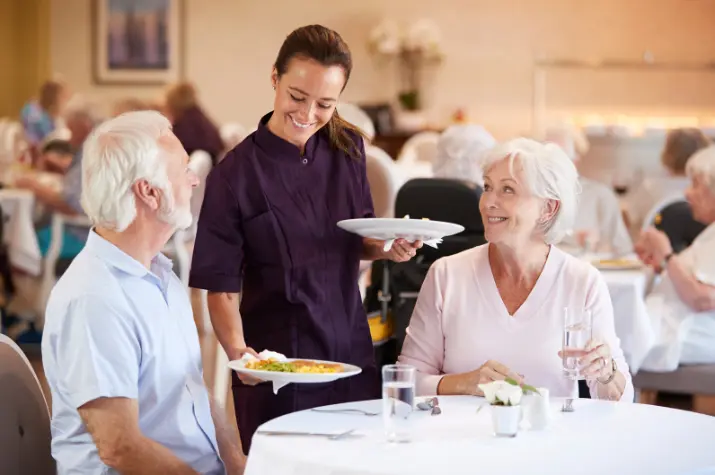
Discovering the essential components that enhance seniors’ quality of life in assisted living settings is a journey into understanding the holistic approach to elderly care.
These eight aspects encompass various facets of well-being, ranging from personalized care plans to emotional support services.
8 Aspects of Assisted Living That Improve Seniors’ Quality of Life
By exploring each aspect of assisted living in detail, we uncover the foundations that contribute to seniors’ overall happiness, health, and fulfillment in their later years.
1. Personalized Care Plans:
Staff members collaborate with seniors and their families to assess individual requirements, considering factors such as medical history, preferences, and mobility levels.
These plans outline specific care interventions and schedules, ensuring that seniors receive the appropriate level of support with activities of daily living.
Regular assessments and adjustments are made to adapt to changing needs, fostering a sense of security and well-being among residents.
By tailoring care plans to the individual, senior living communities strive to enhance the quality of life for every resident, promoting independence and dignity in their daily routines.
2. Social Engagement Activities:
Social engagement activities in senior living communities are carefully curated to encourage interaction and connection among residents.
These activities encompass a wide range of options, including group outings, arts and crafts sessions, game nights, and themed parties.
Regularly scheduled events provide opportunities for seniors to meet new friends, share experiences, and participate in stimulating conversations.
Additionally, recreational amenities such as communal lounges, libraries, and gardens offer inviting spaces for relaxation and socialization.
3. Nutritious Dining Options:

Culinary professionals carefully craft menus to offer balanced meals that are both flavorful and nourishing.
Dietary needs are catered for with special attention to low-sodium, diabetic-friendly, and gluten-free options. Residents can enjoy a variety of fresh fruits, vegetables, lean proteins, and whole grains to support their overall health and well-being.
Additionally, communal dining spaces provide opportunities for socialization and enjoyment of meals in a pleasant atmosphere.
By prioritizing nutritious dining options, senior living communities promote healthy eating habits and enhance the overall quality of life for their residents.
4. Safe and Accessible Environment:
Ensuring a safe and accessible environment is paramount in senior living communities. Facilities are designed with handrails, non-slip flooring, and well-lit corridors to promote mobility and prevent accidents.
Additionally, emergency response systems and 24-hour staff availability provide peace of mind to senior living residents in Minnesota, knowing that help is always within reach.
Regular maintenance and safety inspections further contribute to creating a secure living space for seniors, fostering independence and confidence in their daily activities.
5. Health Monitoring and Medication Management:
Health monitoring and medication management are integral aspects of senior living communities, ensuring residents receive the necessary support to maintain their well-being.
Trained staff members conduct regular health assessments, including vital sign monitoring and wellness checks, to identify any changes in residents’ health status promptly.
Drug management services also assist seniors in following their recommended drug schedules, which lowers the possibility of medication errors or missing doses.
By prioritizing health monitoring and medication management, senior living communities promote proactive healthcare management and overall wellness among their residents.
6. Supportive Staff:

Supportive staff members play a crucial role in senior living communities, providing residents with compassionate assistance and personalized care.
Trained experts create a safe and supportive environment in addition to assisting with daily living chores including dressing, grooming, and bathing.
In addition, employees are on duty twenty-four hours a day to attend to residents’ requirements and guarantee their comfort and safety.
Their dedication to serving seniors with dignity and respect contributes to the overall well-being and satisfaction of residents in senior living communities.
7. Physical Fitness Programs:
Physical fitness programs offer various exercise options suitable for different fitness levels, including chair exercises, yoga, walking clubs, and water aerobics.
Energetic programs with a focus on strengthening, flexibility, balance, and cardiovascular health are taught by certified fitness instructors.
Frequent engagement in these activities improves seniors’ physical health as well as their social networks and sense of achievement.
Senior living facilities encourage people to keep an active and meaningful lifestyle as they age by highlighting the significance of doing so.
8. Emotional Support Services:
Emotional support services in senior living communities are designed to address the diverse emotional needs of residents. These services may include counseling sessions, support groups, and individual therapy sessions facilitated by trained professionals.
Additionally, social workers and chaplains are available to provide spiritual guidance and emotional comfort to residents facing challenges or transitions.
By offering a range of emotional support resources, senior living communities strive to create a nurturing and compassionate environment where residents feel valued, heard, and supported in their emotional well-being.
Conclusion on Assisted Living
By prioritizing personalized care plans, social engagement activities, nutritious dining options, and a safe environment, senior living communities offer the support necessary for a fulfilling lifestyle.
Additionally, health monitoring, supportive staff, physical fitness programs, and emotional support services further enhance seniors’ overall happiness and satisfaction.
About The Author:
Stacey Smith is a freelance health writer. She is passionate about writing about women’s health, dental health, diabetes, endocrinology, and nutrition and provides in-depth features on the latest in health news for medical clinics and health magazines.




